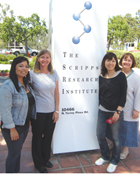
Scientists at The Scripps Research Institute have uncovered a molecular interaction between two cell types that may play a key role in wound healing. Their discovery could lead to quicker wound healing options.
The team’s study demonstrates a skin-cell receptor hook-up with a receptor on gamma delta T cells to stimulate wound healing.
“This is a major activation pathway for gamma delta T cells, and it may be a key to treating slow-wound-healing conditions, such as we see in diabetes,” said Wendy L. Havran, Ph.D., the senior author of the study.
Havran’s team has produced many of the findings in this research field, including the discovery of these cells’ major role in epithelial wound repair. Epithelial tissues are barrier tissues to the outside world, such as skin and the inner surfaces of the gut and lungs.
Normally, gamma delta T cells reside in these tissues and extend finger-like projections, called dendrites. When injury or infection occurs, the epithelial cells signal their damaged condition to the gamma delta T cells. In response, the T cells retract their dendrites, become round, start proliferating, and secrete growth-factor proteins that stimulate the production of new epithelial cells in the vicinity — thus helping to repair the wound.
Full findings appear in Immunity Magazine.
From the October 01, 2012 Issue of McKnight's Long-Term Care News




